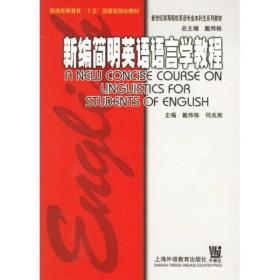
新编简明英语语言学教程(第2版)/新世纪高等院校英语专业本科生系列教材(修订版)
¥ 15 5.0折 ¥ 30 八品
仅1件
广东广州
认证卖家担保交易快速发货售后保障
作者戴炜栋、何兆熊、戴炜栋 编
出版社上海外语教育出版社
出版时间2018-05
版次2
装帧平装
上书时间2024-08-11
- 最新上架
商品详情
- 品相描述:八品
- 本店书籍较多,统一标为八品
- 商品描述
- 本书有笔记
图书标准信息
- 作者 戴炜栋、何兆熊、戴炜栋 编
- 出版社 上海外语教育出版社
- 出版时间 2018-05
- 版次 2
- ISBN 9787544653060
- 定价 30.00元
- 装帧 平装
- 开本 16开
- 纸张 胶版纸
- 页数 199页
- 字数 258千字
- 正文语种 简体中文,英语
- 丛书 新世纪高等院校英语专业本科生系列教材(修订版);“十二五”普通高等教育本科国家级规划教材
- 【内容简介】
-
本系列教材按照英语专业教学大纲设计,旨在打造完整的英语专业学科体系,全面促进学生的语言技能、学科素养和创新能力的培养,为我国培养国际化、创新型、高素质的英语专业人才奠定基础。本次整合改版并重新设计装帧后出版,以更好地适应市场需求。
《新编简明英语语言学教程(第2版)/新世纪高等院校英语专业本科生系列教材(修订版)》为其中的语言学教程,供语言学课程使用。 - 【目录】
-
Chapter 1 Introduction
1.1 What is linguistics?
1.1.1 Definition
1.1.2 The scope of linguistics
1.1.3 Some important distinctions in linguistics
1.2 What is language?
1.2.1 Definitions of language
1.2.2 Design features of language
1.2.3 Functions of language
Revision exercises
For further reading
Chapter 2 Phonology
2.1 The phonic medium of language
2.2 Phonetics
2.2.1 What is phonetics?
2.2.2 Organs of speech
2.2.3 Orthographic representation of speech sounds ——broad and narrow transcriptions
2.2.4 Classification of English speech sounds
2.3 Phonology
2.3.1 Phonology and phonetics
2.3.2 Phone, phoneme, and allophone
2.3.3 Phonemic contrast, complementary distribution, and minimal pair
2.3.4 Some rules in phonology
2.3.5 Suprasegmental features —— stress, tone, intonation
Revision exercises
For further reading
Chapter 3 Morphology
3.1 Introduction
3.2 Open class and closed class
3.3 Morphemes —— the minimal units of meaning
3.4 Analyzing word structures
3.5 Derivational and inflectional morphemes
3.6 Morphological rules of word formation
3.7 Derivation
3.8 Compounds
Revision exercises
For further reading
Chapter 4 Syntax
4.1 What is syntax?
4.2 Categories
4.2.1 Word-level categories
4.2.2 Phrase categories and their structures
4.3 Phrase structure rule
4.3.1 XPrule
4.3.2 Coordination rule
4.4 Phrase elements
4.4.1 Specifiers
4.4.2 Complements
4.4.3 Modifiers
4.5 Sentences (The S rule)
4.6 Transformations
4.6.1 Auxiliary movement
4.6.2 Do insertion
4.6.3 Deep structure and surface structure
4.6.4 Wh movement
4.6.5 Move a and constraints on transformations
Revision exercises
For further reading
Chapter 5
5.1 What is semantics?
5.2 Some views concerning the study of meaning
5.2.1 The naming theory
5.2.2 The conceptualist view
5.2.3 Contextualism
5.2.4 Behaviorism
5.3 Lexical meaning
5.3.1 Sense and reference
5.3.2 Major sense relations
5.4 Sense relations between sentences
5.5 Analysis of meaning
5.5.1 Componential analysis —— a way to analyze lexical meaning
5.5.2 Predication analysis —— a way to analyze sentence meaning
Revision exercises
For further reading
Chapter 6 Pragmatics
6.1 Some basic notions
6.1.1 Definition
6.1.2 Pragmatics vs. semantics
6.1.3 Context
6.1.4 Sentence meaning vs. utterance meaning
6.2 Speech act theory
6.2.1 Austin's model of speech acts
6.2.2 Searle's classification of speech acts
6.2.3 Indirect speech acts
6.3 Principle of conversation
6.4 Cross-cultural pragmatic failure
Revision exercises
For further reading
Chapter 7 Language Change
7.1 Introduction
7.2 Phonological changes
7.3 Morphological and syntactic change
7.3.1 Addition of affixes
7.3.2 Loss of affixes
7.3.3 Change of word order
7.3.4 Change in negation rule
7.4 Lexical and semantic change
7.4.1 Addition of new words
7.4.2 Loss of words
7.4.3 Semantic changes
7.5 Some recent trends
7.5.1 Moving towards greater informality
7.5.2 The influence of American English
7.5.3 The influence of science and technology
7.6 The causes of language change
Revision exercises
For further reading
Chapter 8 Language and Society
8.1 The scope of sociolinguistics
8.1.1 The relatedness between language and society
8.1.2 Speech community and speech variety
8.1.3 Two approaches to sociolinguistic studies
8.2 Varieties of language
8.2.1 Dialectal varieties
8.2.2 Register
8.2.3 Degree of formality
8.3 Standard dialect
8.4 Pidgin and Creole
8.5 Bilingualism and diglossia
Revision exercises
For further reading
Chapter 9 Language and Culture
9.1 Introduction
9.2 What is culture?
9.3 The relationship between language and culture
9.4 Sapir-Whorf Hypothesis
9.5 Linguistic evidence of cultural differences
9.5.1 Greetings and terms of address
9.5.2 Gratitude and compliments
9.5.3 Colour words
9.5.4 Privacy and taboos
9.5.5 Rounding off numbers
9.5.6 Words and cultural-specific connotations
9.5.7 Cultural-related idioms, proverbs and metaphors
9.6 Culture contact, cultural overlap and diffusion
9.7 The significance of cultural teaching and learning
9.8 Intercultural communication
Revision exercises
For further reading
Chapter 10 Language Acquisition
10.1 Introduction
10.2 Theories of child language acquisition
10.2.1 A behaviourist view of language acquisition
10.2.2 An innatist view of language acquisition
10.2.3 An interactionist view of language acquisition
10.3 Cognitive development in child language development
10.4 Language environment and the Critical Period Hypo thesis
10.5 Stages in child language development
10.5.1 Phonological development
10.5.2 Vocabulary development
10.5.3 Grammatical development
10.5.4 Pragmatic development
10.6 Atypical development
Revision exercises
For further reading
Chapter 11 Second Language Acquisition
11.1 Introduction
11.2 Connections between first language acquisition and second language acquisition
11.3 Contrastive analysis
11.4 Error analysis
11.5 Interlanguage
11.6 The role of the native language in second language learning
11.7 Second language learning models and input hypothesis
11.8 Individual differences
11.9 Second language acquisition and its pedagogical implications
Revision exercises
For further reading
Chapter 12 Language and the Brain
12.1 Introduction
12.2 Neurolinguistics
12.2.1 What is neurolinguistics?
12.2.2 The struce and function of the human brain
12.2.3 Methods for the study of the brain and evidences for lateralization
12.2.4 Aphasia
12.3 Psycholinguistics
12.3.1 What is psycholinguistics?
12.3.2 Psycholinguistic research methods
12.3.3 Linguistics and language processing
12.3.4 Psycholinguistic modeling
Revision exercises
For further reading
A Glossary in English and Chinese
References
点击展开
点击收起
相关推荐
— 没有更多了 —

















以下为对购买帮助不大的评价